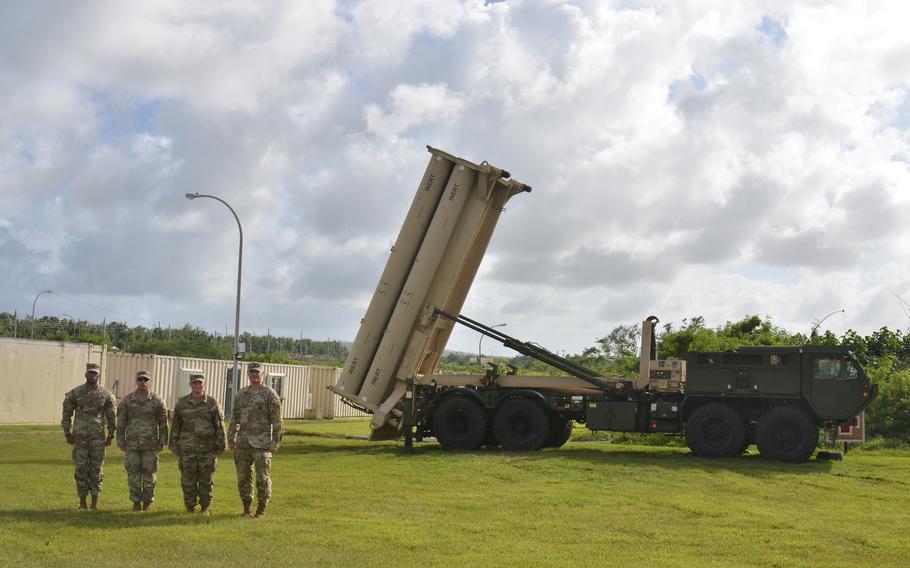
Soldiers stand near a Terminal High Altitude Area Defense, or THAAD, launcher on Guam, Nov. 30, 2023. (Seth Robson/Stars and Stripes)
The Pentagon should rethink its plans for missile defense on Guam and consider less expensive technology with a lighter footprint, according to a former Navy destroyer captain.
Retired naval officer J.D. Gainey called for a pause on plans for Guam’s Enhanced Integrated Air and Missile Defense System during an online forum Friday.
Gainey, who specializes in Indo-Pacific security, commanded the USS Hopper, an Aegis-equipped destroyer, and was part of a 2018 effort to plan to defend Guam from air and missile attacks, according to the Missile Defense Advocacy Alliance, the group that sponsored the forum.
After retiring from the Navy, Gainey joined the board of the Virginia-based nonprofit that lobbies for missile defense, deployment and development, according to its website.
The threat to Guam includes ballistic, cruise and hypersonic missiles, Gainey said during the forum, noting that China has demonstrated the ability to target forces at a range of 2,000 miles.
The Missile Defense Agency’s plan to defend Guam calls for up to 20 new military sites across the island, to be operational by 2027.
“The MDA and the Army need to strategically locate and integrate various system components, including a command and control center, radars, sensors, missile launchers, missile interceptors, and support facilities, at multiple sites around Guam,” the agency states on its website.
However, Gainey said the cost of the dispersed missile defense system will be astronomical.
“We need to take a pause,” he said, before adding that the requirement to defend the island remains the same, along with the need to be ready by 2027.
The U.S. military projects air and sea power from Guam, its westernmost Pacific territory.
The cost of planned military construction on the island will likely increase beyond a projected $60 billion, alliance chairman Riki Ellison said during the forum.
Meanwhile, Chinese President Xi Jinping has said he wants his military ready to invade Taiwan by 2027, Ellison said.
“There has to be capabilities to defend against the best threats that China is deploying,” he said.
The Navy would probably assign four Aegis destroyers to defend Guam in a crisis if the island’s land-based missile defense system isn’t ready, Ellison said.
Arleigh Burke-class guided missile destroyers are equipped with the Aegis Combat System, which uses high-tech radars and computers to track enemy missiles so they can be shot down with interceptor missiles.
The distributed missile defense system planned for Guam involves truck-mounted, mobile launchers.
That plan requires numerous safe areas where missile booster rockets may fall, up to 1,000 service members and support services such as schools and a commissary, said Mark Montgomery, a retired Navy rear admiral and an alliance board member.
A better option against a hypersonic missile threat would be a pair of vertical launch systems, of the type installed on Aegis destroyers, defend Andersen Air Force Base and Naval Base Guam, Montgomery said during the forum.
That plan could be ready in 2 ½ years and would free up Aegis destroyers to defend aircraft carriers or attack the enemy with Tomahawk missiles in a contingency, Montgomery said.
The Navy should man the system, but the Army could support it with its Terminal High Altitude Area Defense, or THAAD, and Patriot missile launchers on Guam if they are available, he said,